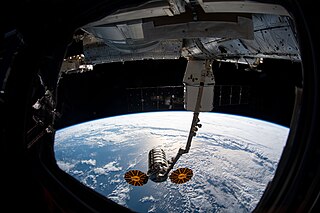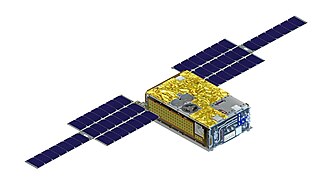
A CubeSat is a class of small satellite with a form factor of 10 cm (3.9 in) cubes. CubeSats have a mass of no more than 2 kg (4.4 lb) per unit, and often use commercial off-the-shelf (COTS) components for their electronics and structure. CubeSats are deployed into orbit from the International Space Station, or launched as secondary payloads on a launch vehicle. As of December 2023, more than 2,300 CubeSats have been launched.

A small satellite, miniaturized satellite, or smallsat is a satellite of low mass and size, usually under 1,200 kg (2,600 lb). While all such satellites can be referred to as "small", different classifications are used to categorize them based on mass. Satellites can be built small to reduce the large economic cost of launch vehicles and the costs associated with construction. Miniature satellites, especially in large numbers, may be more useful than fewer, larger ones for some purposes – for example, gathering of scientific data and radio relay. Technical challenges in the construction of small satellites may include the lack of sufficient power storage or of room for a propulsion system.
Technology Education Satellite (TechEdSat) is a successful nano-sat flight series conducted from the NASA Ames Research Center in collaboration with numerous universities. While one of the principal aims has been to introduce young professionals and university students to the practical realm of developing space flight hardware, considerable innovations have been introduced. In addition, this evolving flight platform has tested concepts for Low Earth Orbit (LEO) sample return, as well as planetary nano-sat class mission concepts.

Antares A-ONE mission was the maiden flight of Orbital Sciences Corporation' Antares launch vehicle including the ascent to space and accurate delivery of a simulated payload, the Cygnus Mass Simulator (CMS), which was launched 21 April 2013. It was launched from Pad 0A at the Mid-Atlantic Regional Spaceport (MARS), Wallops Flight Facility, Virginia. The simulated payload simulates the mass of the Cygnus cargo spacecraft. This dummy payload was sent into an orbit of 240 km × 260 km with an orbital inclination of 51.6°, the same launch profile it uses for Orbital's Cygnus cargo supply missions to the International Space Station (ISS) for NASA.

The Nanoracks CubeSat Deployer (NRCSD) is a device to deploy CubeSats into orbit from the International Space Station (ISS).

AESP-14 is a Brazilian 1U Cubesat developed by multiple Brazilian institutions. It was launched on 10 January 2015 aboard the SpaceX CRS-5 mission on a Falcon 9 v1.1 rocket. It was the first Brazilian Cubesat ever launched into space.
Tyvak Nano-Satellite Systems was an American company designing and building satellites. It started as a designer, builder and provider of nanosatellite and CubeSat space vehicle products and services for government and commercial customers. Tyvak was based in Irvine, California. It was a subsidiary of Terran Orbital Corporation. In 2022, it was announced that Tyvak would transition into larger satellites from nanosats and cubesats and the name Tyvak would be phased out in favor of the name of the parent company Terran Orbital.

NG-11, previously known as OA-11, is the twelfth flight of the Northrop Grumman robotic resupply spacecraft Cygnus and its eleventh flight to the International Space Station under the Commercial Resupply Services (CRS-1) contract with NASA. The mission launched on 17 April 2019 at 20:46:07 UTC. This is the last mission from the extended CRS-1 contract; follow-up missions are part of the CRS-2 contract. Cygnus NG-11 was also the first mission to load critical hardware onto Cygnus within the last 24 hours prior to launch, a new Antares feature.

ArgoMoon is a CubeSat that was launched into a heliocentric orbit on Artemis 1, the maiden flight of the Space Launch System, on 16 November 2022 at 06:47:44 UTC. The objective of the ArgoMoon spacecraft is to take detailed images of the Interim Cryogenic Propulsion Stage following Orion separation, an operation that will demonstrate the ability of a cubesat to conduct precise proximity maneuvers in deep space. ASI has not confirmed nor denied whether this took place, but several images of the Earth and the Moon were taken.

BRAC Onnesha was the first nanosatellite built in Bangladesh to be launched into space. The satellite was designed and built in conjunction with Kyushu Institute of Technology Birds-1 program, which has the goal of helping countries build their first satellite. It was designed and built over a two-year period.

EQUULEUS is a nanosatellite of the 6U CubeSat format that will measure the distribution of plasma that surrounds the Earth (plasmasphere) to help scientists understand the radiation environment in that region. It will also demonstrate low-thrust trajectory control techniques, such as multiple lunar flybys, within the Earth-Moon region using water steam as propellant. The spacecraft was designed and developed jointly by the Japan Aerospace Exploration Agency (JAXA) and the University of Tokyo.
NepaliSat-1, also known as Bird NPL, was a Nepalese low orbit research satellite and the first satellite of Nepal. Along with a Sri Lankan satellite, Raavana 1, it was launched as part of Cygnus NG-11 by the United States on 17 April 2019. It reached the International Space Station on 19 April 2019, to be deployed later, and was estimated to revolve the Earth for six months.

IceCube, also known as Earth-1, was a 3U CubeSat satellite funded and developed by NASA. Its goal was to demonstrate and map ice clouds through the use of its 883 GHz radiometer.
Maya-2 was a Filipino nanosatellite. It succeeded Maya-1, the first Filipino nanosatellite, which was deorbited in November 2020.
The Lume-1 is a Spanish nanosatellite developed for educational and scientific purposes by the University of Vigo in cooperation with Alén Space, the University of Porto and the French National Centre of Scientific Research. The satellite is part of the Fire-RS program in order to battle wildfires.

Cosmic X-ray Background Nanosatellite-2 was a satellite and mission developed by the Morehead State University to follow up on the CXBN mission launched in 2012. It was an improved version of the previous spacecraft and it increased the precision of measurements of the cosmic X-ray background in the 30-50 keV range and helped to improve understanding of the early universe.
Cosmic X-ray Background Nanosatellite (CXBN) was a satellite and mission developed by the Morehead State University. Unlike its successor, it was a partial failure as its transmissions were too weak for its mission due to it going into an anomalous low power mode. It was supposed to take measurements of the cosmic X-ray background in the 30-50 keV range and temporarily supplement NASA's Radiation Belt Storm Probes.
TUMnanoSAT was a nanosatellite and the first artificial satellite made by Moldova. It was built by the Technical University of Moldova (UTM) and was launched on 15 July 2022. SpaceX's Falcon 9 rocket carried TUMnanoSAT to the International Space Station (ISS). This was through the SpaceX CRS-25 Commercial Resupply Service mission. In this mission, Falcon 9 carried a SpaceX Dragon 2 spacecraft which contained the J-SSOD launch capsule of the Japan Aerospace Exploration Agency (JAXA) within which in turn was TUMnanoSAT. The satellite project and its launch was carried out in cooperation with the JAXA and the United Nations Office for Outer Space Affairs (UNOOSA) as part of the KiboCUBE program. Once brought to the ISS, TUMnanoSAT was put into orbit from there on 12 August.









